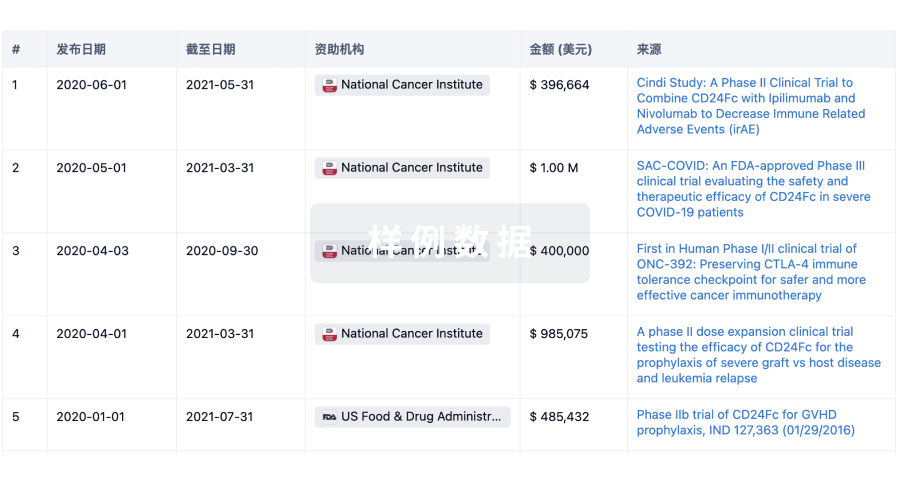预约演示
更新于:2025-05-07

CdmoGen Co., Ltd.
更新于:2025-05-07
概览
标签
眼部疾病
遗传病与畸形
内分泌与代谢疾病
基因疗法
腺相关病毒基因治疗
疾病领域得分
一眼洞穿机构专注的疾病领域
暂无数据
技术平台
公司药物应用最多的技术
暂无数据
靶点
公司最常开发的靶点
暂无数据
| 排名前五的药物类型 | 数量 |
|---|---|
| 基因疗法 | 5 |
| 腺相关病毒基因治疗 | 3 |
| 排名前五的靶点 | 数量 |
|---|---|
| mTOR(丝氨酸/苏氨酸蛋白激酶mTOR) | 2 |
| EGFR(表皮生长因子受体erbB1) | 1 |
| PDE6B | 1 |
关联
8
项与 CdmoGen Co., Ltd. 相关的药物靶点 |
作用机制 mTOR抑制剂 |
非在研适应症- |
最高研发阶段临床申请 |
首次获批国家/地区- |
首次获批日期- |
靶点 |
作用机制 EGFR调节剂 [+1] |
非在研适应症- |
最高研发阶段临床申请 |
首次获批国家/地区- |
首次获批日期- |
靶点- |
作用机制- |
在研适应症 |
非在研适应症- |
最高研发阶段药物发现 |
首次获批国家/地区- |
首次获批日期- |
100 项与 CdmoGen Co., Ltd. 相关的临床结果
登录后查看更多信息
0 项与 CdmoGen Co., Ltd. 相关的专利(医药)
登录后查看更多信息
12
项与 CdmoGen Co., Ltd. 相关的文献(医药)2025-03-01·Molecular Therapy Methods & Clinical Development
mTOR downregulation promotes anti-inflammatory responses via the CCL3-CCR5 axis in hypoxic retinopathy
Article
作者: Lee, Joo Yong ; Moon, Tae Kwon ; Lee, Kyoung Jin ; Lee, Heuiran ; Han, A Reum ; Kim, Hee Jong ; Park, Keerang ; Woo, Ha-Na ; Kim, Ji Hyun ; Choi, Jun-Sub ; Kang, Im Kyeung
2022-10-13·Advances in Cell and Gene Therapy
Intravitreally Administered Soluble VEGF Receptor-1 Variant Tested as a Potential Gene Therapeutic for Diabetic Retinopathy
作者: Choi, Jun-Sub ; Cha, Seho ; Kim, Hee Jong ; Woo, Ha-Na ; Kang, Im Kyeung ; Lee, Steven Hyun Seung ; Lee, Heuiran ; Park, Keerang ; Kim, Jin ; Lee, Joo Yong ; Lee, Kyoung Jin
2020-02-27·Investigative Opthalmology & Visual Science2区 · 医学
Inhibition of mTOR via an AAV-Delivered shRNA Tested in a Rat OIR Model as a Potential Antiangiogenic Gene Therapy
2区 · 医学
ArticleOA
作者: Lee, Joo Yong ; Lee, Steven Hyun Seung ; Woo, Ha-Na ; Park, Keerang ; Kim, Hee Jong ; Kim, Ji Hyun ; Chung, Sunho ; Chang, HeeSoon ; Choi, Jun-Sub ; Lee, Heuiran ; Lee, Kyoung Jin
100 项与 CdmoGen Co., Ltd. 相关的药物交易
登录后查看更多信息
100 项与 CdmoGen Co., Ltd. 相关的转化医学
登录后查看更多信息
组织架构
使用我们的机构树数据加速您的研究。
登录
或

管线布局
2025年09月16日管线快照
管线布局中药物为当前组织机构及其子机构作为药物机构进行统计,早期临床1期并入临床1期,临床1/2期并入临床2期,临床2/3期并入临床3期
药物发现
6
2
临床申请
登录后查看更多信息
药物交易
使用我们的药物交易数据加速您的研究。
登录
或

转化医学
使用我们的转化医学数据加速您的研究。
登录
或

营收
使用 Synapse 探索超过 36 万个组织的财务状况。
登录
或

科研基金(NIH)
访问超过 200 万项资助和基金信息,以提升您的研究之旅。
登录
或

投资
深入了解从初创企业到成熟企业的最新公司投资动态。
登录
或

融资
发掘融资趋势以验证和推进您的投资机会。
登录
或

Eureka LS:
全新生物医药AI Agent 覆盖科研全链路,让突破性发现快人一步
立即开始免费试用!
智慧芽新药情报库是智慧芽专为生命科学人士构建的基于AI的创新药情报平台,助您全方位提升您的研发与决策效率。
立即开始数据试用!
智慧芽新药库数据也通过智慧芽数据服务平台,以API或者数据包形式对外开放,助您更加充分利用智慧芽新药情报信息。
生物序列数据库
生物药研发创新
免费使用
化学结构数据库
小分子化药研发创新
免费使用
